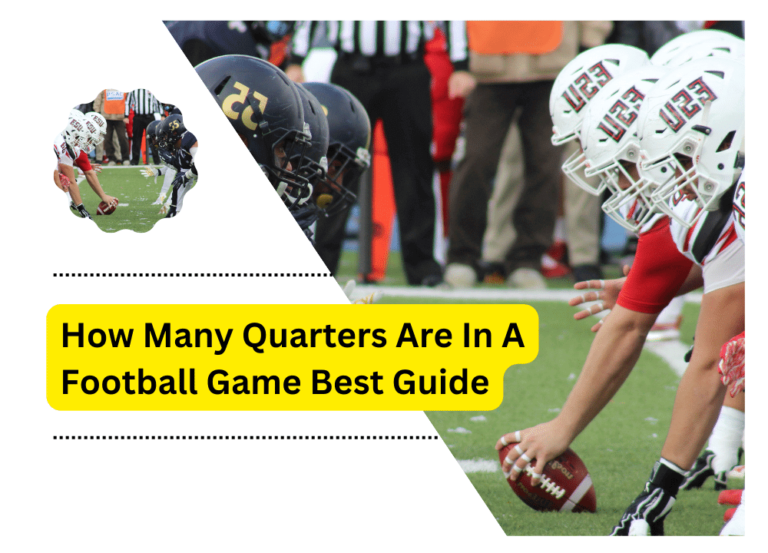How To Run Faster In Football? (Ultimate Ways)

Speed may mean winning and losing in the fiercely competitive football world. Whether you’re a professional athlete or an ambitious young player; speed training is essential to raising your game. That’s why knowing how to run faster in football is all you need.
Several critical elements are needed to increase your football speed and agility. But, no more worries, our detailed guide will not only help you to increase your speed but you will be able to easily understand the ups & downs of pace highlight football.
The Value of Football Speed Training
Players are better able to quickly shift directions, avoid tackles, and set up scoring opportunities, which improves performance on the field.
Football depends heavily on speed, which impacts both the offense and the game’s defense.
Along with helping athletes outpace their opponents, speed training enhances agility, reaction quickness, and rapid decision-making. If you incorporate them into your regimen, speed training exercises may improve your overall football play.
Additionally, speed training lowers the chance of injury by enhancing joint stability, flexibility, and muscle balance.
Here are some critical football speed fasting tips.
A great drill to increase speed in football
These exercises demonstrate specialized tools that not everyone may have access to. Make use of your resources in each situation to accomplish the same objective. For instance, if no hurdles are available, utilize cones or another object that will motivate you to clear a set height.
Concentrate on your running form.
You should move your arms as quickly as your feet.
- Arm movements are an essential element in sprinting.
- The arms should be held freely at right angles and forced back as far as possible at the elbow.
- In other words, you want to generate momentum by moving your arms back and forth.
- If your arms swing from side to side, practice below to correct your technique. Pump your hands up to shoulder height as you turn backward.
- Remind yourself to maintain relaxed shoulders and arms.
Sprint Training
Include sprint training in your workouts to improve your sprinting prowess. It incorporates interval training, alternating between sprints at a high-speed rate. Perform sprint drills to increase your top speed. You may raise your peak speed by practicing reaching high speeds over short distances.
Sprint exercise is simple and all you need to do is.
- Cover 22–33 yards (20–30 meters) at your fastest pace.
- During the workout, make sure your arm motion is fluid and relaxed.
- The distance between the arms should be close to the body.
- Make sure to take steady, even strides.
- Maintain a comfortable, natural position for your head.
- After the sprint, slowly jog or stroll back to your starting location.
- Do this exercise 2-4 times.
Implement a speed ladder.r
Your lower body agility, balance, coordination, and speed will all improve due to speed ladder training. As you run,
- You must alternate your feet across the rungs of this horizontal gadget.
- Train with the ladder while keeping track of time using a timer to increase your speed.
- Speed ladders are offered online and at several sporting supply retailers.
Exercise With Resistance Is Crucial
Experience proves that strength training improves stride length. In this, you have to use your strength as much as possible.
- With resistance bands, you may perform many drills to boost your speed. Resistance training entails applying various types of resistance to increase strength and power.
- This training can aid athletes in accelerating their sprinting pace through increased muscle mass and improved explosive strength.
- These drills engage your fast-twitch muscle fibers, which provide speed and power.
- Football players need rapid, explosive power; fast twitch muscles are vital.
Increase Your Plyometric Training
Plyometric exercise programs focus on using the most force possible in the shortest period.
- To boost your speed, you can perform a variety of plyometric activities.
- Plyometric leaps are potent exercises that require jumping and landing rapidly.
- These workouts enhance the explosive force necessary for sprinting and swiftly accelerating.
- Box jumps, single-leg hops, and depth leaps are a few plyometric jumps.
Rest the body for some time.
Give your body enough time to relax and heal in between exercise sessions. Overtraining can result in weariness, poor performance, and an elevated risk of injury. Give yourself enough time to rest, drink plenty of water, and think about adding active recovery activities like swimming or mild running to your schedule.
Utilize these recommendations for speed training by including these exercises in your training regimen.
Establishing a Training Schedule
Players may employ some tactics to maximize the impact of their speed training in addition to these particular speed training routines.
- Football requires direction changes.
Football requires a lot of direction changes; thus, agility is essential. Increase your skill by including shuttle runs, ladder exercises, and cone drills in your workout regimen. These drills aid in developing fast feet, coordination, and the capacity for swift direction changes.
- Work on sprinting mechanics.
Work on specific sprinting mechanics, such as arm swing and knee drive. Driving forward and backward should be accomplished with your arms moving in unison with your legs. Avoid crossing your arms across your body and maintain a 90-degree angle at your elbows.
- Proper Warm-up
Always begin your workout with a vigorous warm-up program that involves running, stretching, and muscle-activating movements. By doing this, you may avoid injuries and get your body ready for strenuous exercise.
- Build Lower Body Strength
Strong leg muscles are essential for producing power and speed. Squats, lunges, and calf raise should all be a part of your regular strength-training regimen. Plyometric workouts like box leaps and bounds can also enhance explosive power.
- Pay attention to the technique.
Running with the proper form may significantly increase your speed. Maintain a calm body, a straight spine, and active core muscles. Frequency and stride length are other significant factors. Maintain a rapid turnover (the number of steps you take per second) while taking longer strides.
- Enhance your acceleration
Acceleration is essential in football since it enables you to achieve your maximum speed swiftly. Include exercises emphasizing quick beginnings and the initial burst of speed—use slide or tension bands to do resistance training exercises or practice brief sprints while standing still.
- Maintaining high mobility and flexibility
Maintaining high mobility and flexibility will increase your running effectiveness. Regularly engage in stretches focusing on your lower back, hips, and legs. Consider including yoga or Pilates in your regimen to improve general flexibility.
- Proper Footwear
Running more quickly and lowering the risk of injury requires wearing the right shoes with the optimum traction and support. Invest in good football cleats that fit comfortably and offer the stability and traction needed in various playing conditions.
- Prioritize technique before speed.
Gaining speed is only helpful if performing a method or exercise well.
Before attempting to boost your speed, ensure you are well-versed in the fundamentals of football and have had plenty of practice using those talents. Prioritize doing things correctly before trying to get quicker at them.
Here Are Some Key Pointers For Good Running Form.
- A good head-up posture
- Hold your shoulders and neck still. Relaxed
- Hips and shoulders that are square
- Feet firmly planted on the ground underneath your center of gravity. Elbows bent at a 90-degree angle.
- Keep your feet firmly planted when moving quickly.
- With each step, raise your front knee high (known as “knee driving”) and straighten your rear leg to generate all your force.
- Start extending your strides as you gain speed and momentum.
Final Verdict
Give your body enough time to relax and heal in between exercise sessions. Overtraining can result in weariness, poor performance, and an elevated risk of injury. Give yourself enough time to rest, drink plenty of water, and think about adding active recovery activities like swimming or mild running to your schedule.
Just keep in mind that it takes time and persistent effort to improve your running pace and form. Maintain your commitment to your training program while monitoring modest improvement. For personalized advice and to keep track of your development, speak with a coach or sports trainer.






